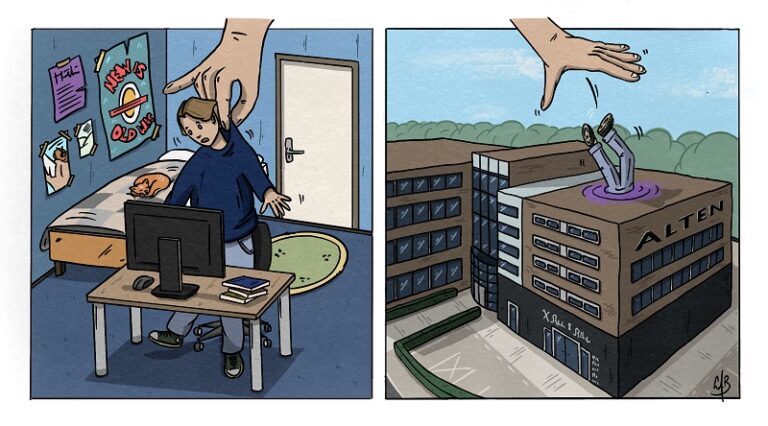“I must not fear. Fear is the mind-killer”
It’s possibly the most recognizable quote from Frank Herbert’s “Dune”: the Bene Gesserit litany against fear. Perhaps it is so memorable because it is so relatable: overwhelming fear. When thinking of fear, one might consider a near-accident in traffic, sudden stage fright before a presentation, or an important test. Often enough, fear is a silent assassin that subtly guides our hands in everyday life choices. Over the years as an Agile consultant for ALTEN, I’ve seen the chokehold of fear on my teams and have sought ways to help them overcome it. In this article, I want to explore this fear, its consequences, and a personal means of dealing with fear myself. In other words, let us together examine the “little death” so that we may learn to overcome it.
“Fear is the little death that brings total obliteration.”
Let me start by saying that fear is not by definition a bad thing. Fear can keep you alert and has kept our ancestors out of the jaws of hungry animals. However, in the modern workspace fear has little function (at least, I hope), yet it can cripple our effectiveness (and enjoyment). To deal with fear-based behavior, the first step is in identifying it. Here are some aspects of fear I’ve often come across in my teams. Fear of failure is relatively commonplace. In the most extreme cases, I’ve seen teams withhold results of their hard work or even cancel Sprint Reviews, because they feared failing in the eyes of their customer. Ironically, this will only result in disappointment in the future as expectations and results will likely diverge further. Fearing failure also stifles experimentation and creativity. Innovation involves leaving the beaten path and taking risks on new technology, techniques, or solutions. If failure is constantly on your mind, you will stay on that beaten path, which is safe, secure, dull, and uninspiring. More sinister and subtle is the fear of conflict. This one can be trickier because its effects might not manifest as apparent. On the surface, everything might seem just fine but if you observe carefully, you notice something is off. Someone is always late for the Daily Scrum, and that does not get addressed. The retrospective is a tame affair, but at the coffee corner they come to you with their grievances. Everyone agrees on a certain solution, sounds of dissent rise from behind the screens. As a Scrum Master, you address these observations with the team and you are treated to a Mexican stare-off: members silently glance at each other, but no one speaks. The result is a false harmony that never results in serious discussion about ideals and allows discontent to fester under the surface until it suddenly erupts like an emotional volcano. Finally, fear of judgment leaves a lot unsaid in our workplace. I’ve seen developers suffer in silence, not daring to ask for help. Junior team members that don’t speak up, even with valid concerns or brilliant ideas, simply because they worry about what others might think. How often do managers think everything is going fine, just because their people don’t dare speak up about the dysfunctional elements in their working environment? There is so much wasted potential and needless anguish, simply because people do not dare to speak up out of fear of being judged. When you have identified fear-based behavior, the next step is to remove its shackles; the answer to that is courage.
“I will face my fear.”
Ever heard the statement “don’t be afraid”? Saying that never made any sense to me. Fear is a primal emotional response that you can’t just shut off. Courage is not about being fearless; courage is the ability to act, despite of fear. Courage is also one of the five core values of Scrum, along with commitment, focus, openness, and respect. Together these values drive the behavior that makes Scrum fly, while at the same time the Scrum framework reinforces these values. Using Scrum , we strive to achieve transparency, that is to make all things known in their true state and understood by all in the same way. This is required to inspect and measure these things and adapt or adjust them if this is required to achieve our goals. Without courage, it is hard to be open and transparent. It requires courage to show things how they are, warts and all. It takes courage to speak up when others remain silent. Courage is needed to dare to try a different path and break away from the status quo. Without courage, Scrum is doomed to fail.
“I will permit it to pass over me and through me.”
If courage is needed to deal with fear, how can you inspire it in your team members? Let me make this bold statement: you cannot teach values. Telling team members about courage and being courageous will not likely do or change anything. The good news is that, as a Scrum Master, you can inspire courage. I firmly believe in walk your talk . You can inspire behavior by setting a good example. How can you expect your team members to find their courage when you don’t dare be bold yourself? For me, courage was a hurdle to take. I am not typically the most outspoken or extrovert person in the room. My personal epiphany on this matter came when I learned to act according to this motto:
“Act relentlessly; apologize sincerely”
I gave myself permission to act, knowing that I might have to apologize for it later and be willing to do so; I could end up doing the wrong thing (for the right reasons) or I could have unintentionally upset someone. However, I am also willing to apologize. I trust the sincerity and best intentions with which I acted will redeem me. This conviction has liberated me from nagging doubt or fear of acting. This “Voice” compels me to act as if a Bene Gesserit was giving me the command herself. Displaying that courage helps others find their own. It shows it is okay to act without permission if the cause is just. It humanizes leaders and the environment your team works in. It shows it’s okay to dare and make mistakes if you also own up to and learn from them. Overall, it adds to the psychologically safe environment for teams to operate in.
“And when it has gone past, I will turn the inner eye to see its path.”
So, this is what I’ve learned on fear and courage. I’ve come to understand courage isn’t about not being afraid; courage is about acting despite of fear and not letting it dictate your (in)actions. I encourage all Scrum Masters to be the best Bene Gesserit teacher to their teams. Help them identify fear-driven behavior and facilitate the discussion on how to overcome it. Whenever possible, inspire courage by setting the example to act free of fear. It might just make all the difference.
“Where the fear has gone there will be nothing. Only I will remain.”
by Rogier den Dulk.
<<< Want to read more? Here's an article on modern architecture for modern data platforms >>>












